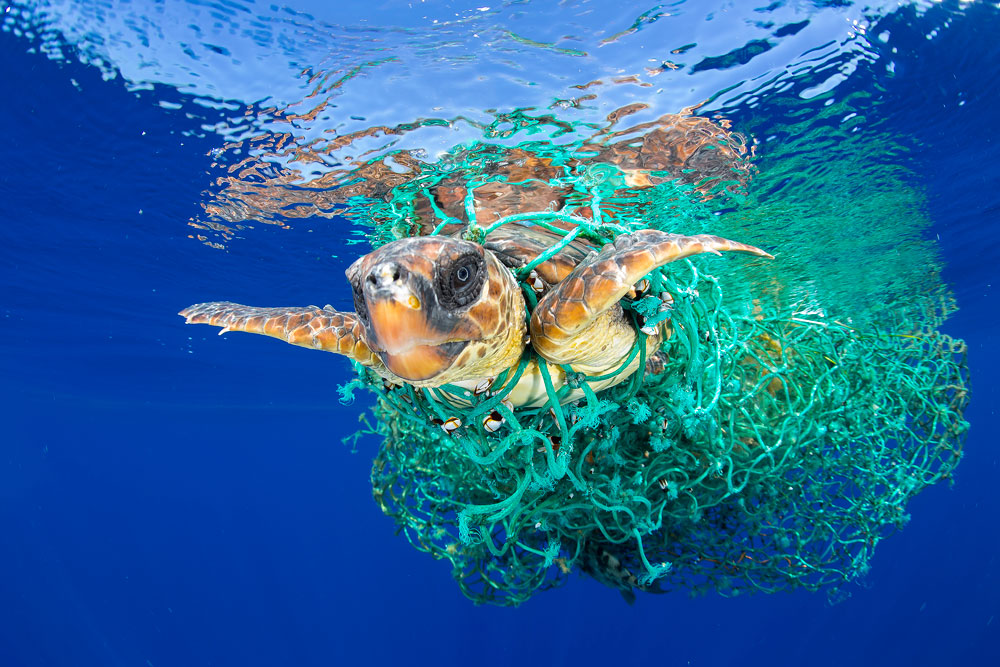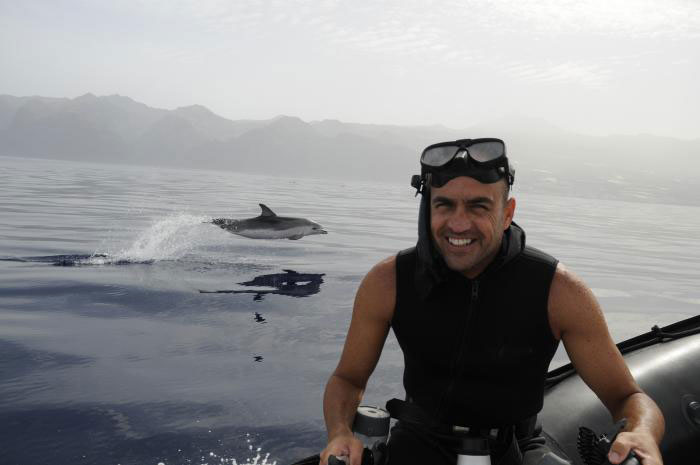An Interview with Franciz Pérez
Underwater Photographer
WPP Prize: Nature – First Prize, Singles
By Anne Pinto-Rodrigues

Caretta Caretta Trapped A loggerhead sea turtle swims entangled in abandoned fishing gear, off the coast of Tenerife, Canary Islands, in the northeast Atlantic Ocean. The loggerhead is classed as a ‘vulnerable’ species globally by the International Union for Conservation of Nature, but the northeast Atlantic subpopulation is listed as ‘endangered’. Entrapment in nets intended for other species, and in gear left abandoned by fishing boats is the prime threat to marine turtles, followed by human consumption of meat and eggs, and coastal development affecting their habitat. © Francis Pérez

Franciz Pérez © All rights reserved.
Francis Pérez was born in Canary Islands and started in underwater photography taking pictures of the sea bed in Tenerife.
As a freelance professional underwater photographer, he focuses on the submarine world with a unique style. His pictures show his own point of view in places such as Indonesia, Red Sea, Malaysia, South Africa, Mozambique, Philippines, Micronesia, Galapagos Islands, Mexico, Chile and Canary Islands, where he has focused on cetaceans.
He’s a collaborator of National Geographic Spain in articles about biodiversity of Canary Islands. His work has been published in many books, such as Blue Hope of Sylvia Earle, Book 50 anniversary of Red List UICN, and many international magazines as National Geographic (Spain) Scuba Diving (USA), Sumerge (South Africa), aQua (Spain), Ocean Geographic (Australia). Awarded with many international prizes as Ocean Geographic (Australia) Ocean view of Nature Best Photography (USA), Por el Planeta of National Geographic and Televisa (Mexico).

Francis Pérez with his prizewinning image ‘Caretta caretta Trapped’ at Canon Night Copyrighted to ©Delioma González
Francis, thank you for agreeing to this interview. Please tell us more about yourself.
I’m an underwater photographer based in Tenerife, Canary Islands, Spain. I’ve been diving since 1994 and started doing underwater photography in 1999. Besides being an ocean lover, I’m also an economist specialized in environmental economics, ecological economics, development and related fields.
I’m very fortunate to be living in Tenerife. We have a big resident population of pilot whales and in summer, I enjoy going freediving to take pictures of them. Sometimes, we also get much larger whales like the Bryde’s whales and I enjoy taking their close-ups as well. So for the last few years, I’ve been focused on photographing cetaceans (marine mammals), taken on some interesting assignments as a freelance professional underwater photographer and have also been published in several magazines.
What got you into photography, specifically underwater photography? How did your career in underwater photography evolve?
A few years after I became a diver, I felt the need to photograph and share with the world, the amazing life I was seeing underwater. With the pictures I had taken, I started participating in underwater photography contests, and began winning some of them. These wins, in various capacities, at international contests such as those conducted by Ocean Geographic, Scuba Diving magazine and Por el Planeta, gave me a lot of visibility. Soon, I was traveling around the world, diving and taking pictures in some spectacular locations across Asia, the Red Sea, Micronesia, Mozambique, South Africa as well as places like Galápagos, Chile, Mexico and Cuba. I’ve been taking underwater pictures for almost 20 years now and I feel I’m at the peak of my professional career.
Congratulations on winning the First prize in the Nature, Singles category with your ‘Caretta caretta Trapped’ image! How does it feel to have won this prize? What does this award mean to you?
Muchas gracias! Every photojournalist aspires for this kind of recognition from WPP. For me, it is a great acknowledgment of my work and of course, motivation to continue doing what I love. It couldn’t have come at a better time.
But I have to be honest and say, my work is not dependent on what prizes I win. Irrespective of what happens, I´ll continue diving and taking pictures. I love the ocean and I´ll always be close by, taking pictures.
Tell us more about this image, ‘Caretta caretta Trapped’.
This image shows the plight of a loggerhead sea turtle (Caretta caretta) which has got entangled in an abandoned fishing net. I took this picture off the coast of Tenerife, in the North Atlantic Ocean. Globally, the loggerhead sea turtle is classified by IUCN as ‘vulnerable’ but the northeast Atlantic subpopulation is considered ‘endangered’. I was deeply saddened when I came across this turtle but I took this image to show what we are doing to the ocean and marine life, with our thoughtless and selfish actions.
Even as I was taking the picture, I was thinking of the animal and how much it was suffering. So I took the picture as quickly as I could and as soon as I was done, my friend and I focused on cutting the net to free the turtle. We only had an old knife with us and it was impossible to cut the net with that knife. I was in despair and the turtle was probably scared too. Minutes were ticking away. Finally, we were able to get a pair of scissors and we managed to set the turtle free. It was such a joy to watch it swim away!
This turtle was free but sadly, a lot of sea creatures in our oceans face this problem. They get trapped, injured or even killed by abandoned fishing gear. It is also reflective of one of the most important environmental problems of our times – plastics pollutants in the ocean which are destroying marine ecosystems.
Read the full article on Lens Magazine Issue #32

